Science of Cornmeal and Polenta
While Polenta is actually a dish and Cornmeal is an ingredient they are also sold in packaged as both Polenta and Cornmeal. Packaged corneal and polenta show the only ingredient is corn. What makes them different is the consistency of the grain. Polenta is generally ground more coarse than cornmeal.
Polenta is usually milled from a special variety of field corn — dent corn or flint corn. Flint corn is distinguished by a hard outer shell and kernels with a range of colors. Dent corn, also known as grain corn, is a type of field corn with a high soft starch content. They are both not the same type as the sweet corn we eat off the cob.
In the small region of Italy, Aosta in the northwest corner of the peninsula, polenta is not just an ordinary pantry staple; it is a daily ritual, the way pasta remains a daily ritual for many people in southern Italy. In the city of Valle d'Aosta polenta is featured on every restaurant and osteria their menu. What makes the best polenta is not the dish but the polenta ingredient itself..
The cornmeal itself, made from local stone-ground field corn, golden in color and toasty in flavor, and --and is cooked at length to bring out the grain’s natural sweetness,
Stone-ground cornmeal retains the hull and germ of the grain, which gives it a pleasing texture and corn flavor when cooked. Many recipes call for coarsely ground cornmeal when making polenta, but you can use coarse, medium, or fine. What type you use is a matter of your own personal preference. Some people prefer polenta that has some texture but is still creamy. Polenta can also be soft or sturdy, depending on the liquid-to-grain ratio, and when you serve it. A 1:4 ratio (one part polenta to four parts liquid) is the standard rule to achieve thick but spoonable polenta. see also ...The secret to heavenly polenta is the cornmeal itself, stone-ground for best flavor
"...Polenta is an ancient food in Italy, dating to the Etruscans. Early versions were made from millet, rye and barley flour. It wasn't until the 17th century, when field corn, a New World ingredient, was introduced to Europe, that polenta became a corn-based dish. ..,"
Best Brands for Polenta
Mulino Marino from Piedmont - Can be purchased from Eataly
"...This Polenta from Mulino Marino is made from the prized otto file corn, grown and harvested in Piemonte and naturally stone ground to retain the flavor and texture of the corn itself. Finely ground, this corn flour makes a soft and creamy polenta...the Mulino Marino stone-grinding mill is located in the small Langhe village of Cossano Belbo in Piemonte...."
Bobs Red Mill Yellow Corn Polenta --
Made with coarsely ground yellow corn. Many gourmet Italian and Mediterranean restaurants feature Bobs Red Mill polenta
If you like your Polenta smooth and creamy?
If you can only purchase a coarse polenta (cornmeal), you can blend your grain (we use a Vitamix) to produce a fine grain. This is my favorite method for a creamy style polenta.
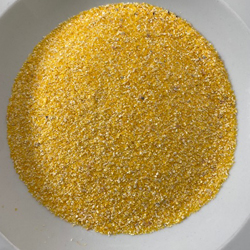
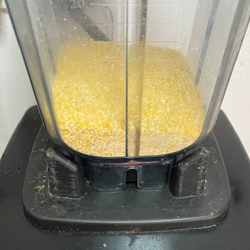
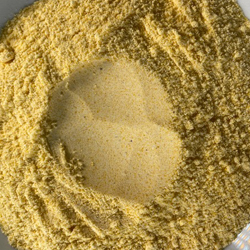
left to right above using Bobs Red Mill: coarse polenta -- vitamix with polenta-- fine smooth blend of polenta
We cook polenta out of the bag about 45 minutes to get a smooth consistency even though the package instructions say 30 minutes. By using a Vitamix to smooth blend the polenta to a powdery consistency the cooking time reduces to 10-15 minutes.
Polenta Cooked in a Pressure Cooker
Using Bobs Red Mill Recipe Using 1 cup Yellow Corn Polenta, 4-5 cups Water and r 2 tsp Salt and butter to taste -- you can cook Polenta in 5 minutes high pressure and rest for 15 minutes. This is not my preferred method. Although it gives a nice Polenta after whisking when done between all the times (including clean up) standard method is better for same texture.
Presoaking Polenta
"From Serious Eats...The trick is to presoak the polenta in its liquid for several hours before cooking it. This step helps fully hydrate the cornmeal before you even start cooking ...'''" ...Coarse grinds result in a firmer and coarser polenta. A finer cornmeal is more suitable for a creamy and soft polenta. .... " see Serious Eats
Health Benefits of Polenta
"...Polenta contains both protein and fiber to help a person feel full. ... Polenta is gluten-free. ...low in fat...low in calories...Rich in complex carbohydrates. ... Contains vitamin A. ... Source of carotenoids. . ... Contains essential minerals. .....Polenta is an excellent source of complex carbohydrates..Simple carbohydrates are broken down fast and can cause a person’s blood sugar levels to spike. ..The complex carbohydrates in polenta are broken down slowly, which means they take longer to digest. This slow release can keep blood sugar levels steady...Polenta contains milled corn, which is a good source of carotenoids. Carotenoids are thought to decrease the risk of certain diseases, such as some types of eye conditions and some cancers..." source
A 1/2-cup (100-gram) serving of polenta cooked in water provides (source)
Calories: 64
Carbs: 13.6 grams
Protein: 1.6 grams
Fat: 0.4 gram
Fiber: 0.8 gram
Sugars (0.0) , Calcium 16mg, Iron 0.29mg, Sodium 216mg.
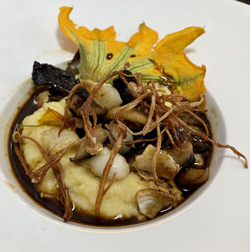
Image above: Polenta with Mushrooms, Pearl Onions, and Dehydrated Zucchini Blossom
Science of Cooking
See also:
Science of Chocolate
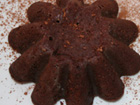
What are the health benefits of Chocolate?
What are the drugs in Chocolate?